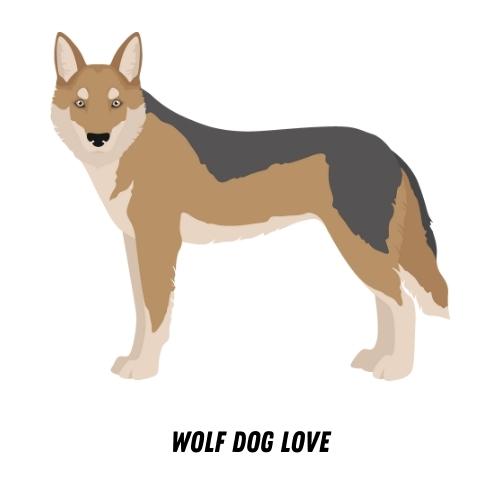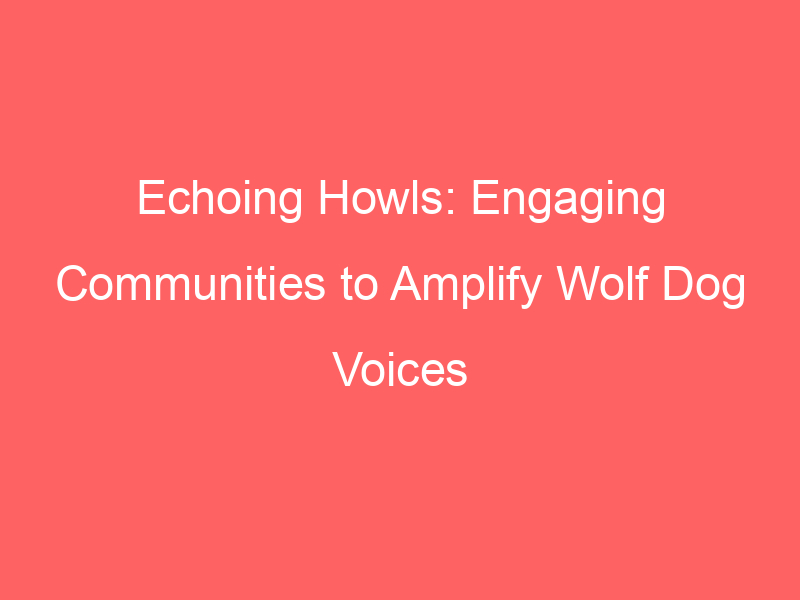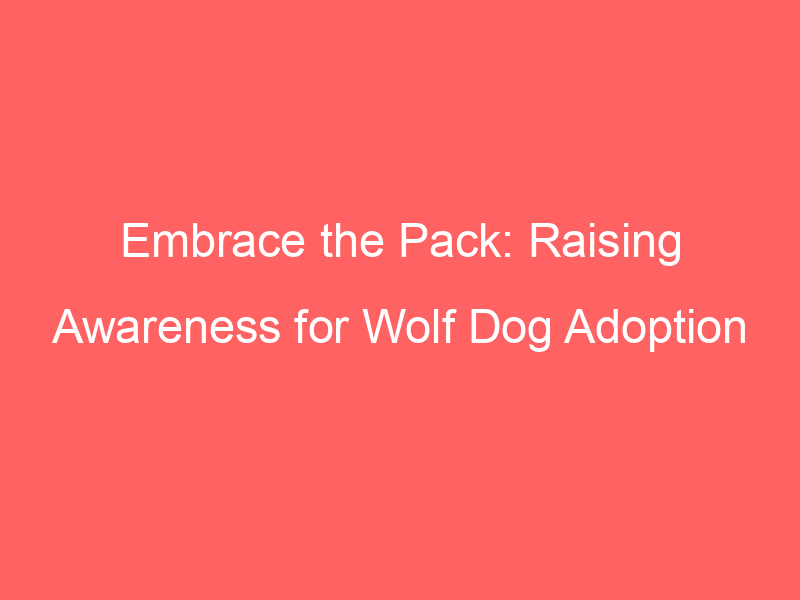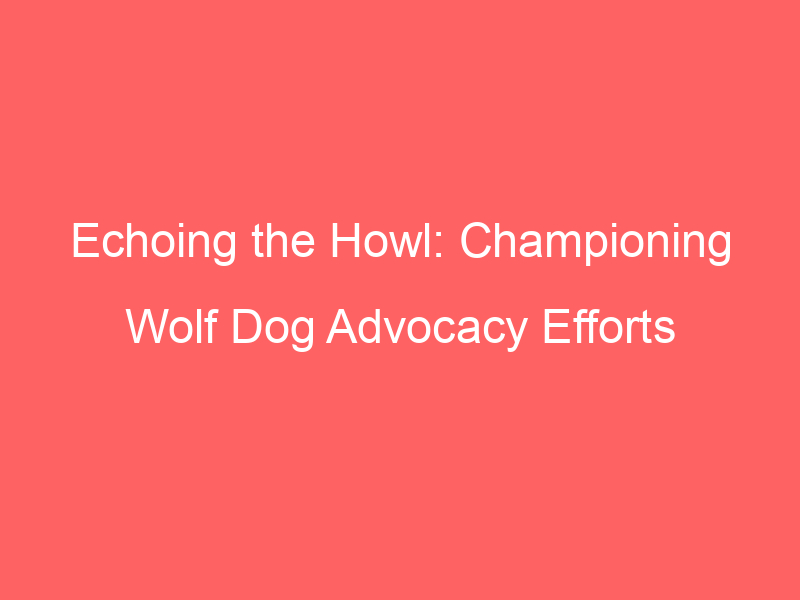Introduction to Wolf Dog Advocacy
Wolf dogs are unique creatures, a blend of wild and domesticated canines. They are often misunderstood, leading to a need for advocacy and protection. This introduction aims to shed light on the importance of wolf dog advocacy and the current state of wolf dog protection.
- Understanding the Importance of Wolf Dog Advocacy
- Current State of Wolf Dog Protection
Wolf dogs are often feared due to their wild heritage. This fear can lead to mistreatment and misunderstanding. Advocacy for these animals is crucial to ensure they are treated with the respect and care they deserve. Advocacy also involves educating the public about the true nature of wolf dogs, dispelling myths and misconceptions.
Wolf dog advocacy is not just about protecting the animals, but also about preserving the balance of our ecosystem. Wolf dogs, like their wild counterparts, play a significant role in maintaining the health of our environment. They control the population of other animals and contribute to biodiversity.
The current state of wolf dog protection is a mixed bag. On one hand, there are many dedicated organizations and individuals working tirelessly to protect and advocate for these animals. They rescue wolf dogs, provide them with proper care, and work to find them safe and loving homes.
On the other hand, there is still much work to be done. Many areas lack adequate laws to protect wolf dogs, and enforcement of existing laws can be inconsistent. Furthermore, public perception of wolf dogs is often negative, leading to challenges in advocacy and protection efforts.
Despite these challenges, the wolf dog advocacy community remains hopeful and committed to their cause. They continue to fight for better laws, educate the public, and provide care for wolf dogs in need. Their work is a testament to the power of advocacy and the love for these unique animals.
Community Engagement in Animal Welfare
Community engagement plays a crucial role in promoting animal welfare. It not only amplifies the voices of animals but also significantly impacts their well-being. Let’s delve deeper into the importance of community involvement in animal care.
Importance of Community Involvement in Animal Care
Community involvement is a powerful tool in the realm of animal welfare. It serves as a platform for raising awareness, promoting empathy, and fostering responsible behavior towards animals. Let’s explore this in more detail.
- Role of Community in Amplifying Animal Voices
- Impact of Community Engagement on Animal Welfare
Animals cannot speak for themselves. They rely on us to understand their needs and ensure their well-being. The community plays a pivotal role in giving voice to these silent creatures. Through various activities like awareness campaigns, rescue operations, and advocacy programs, the community can highlight the plight of animals and mobilize resources to help them.
Community engagement has a profound impact on animal welfare. It not only raises awareness about the needs of animals but also fosters a culture of empathy and compassion towards them. For instance, community-led initiatives like adoption drives, spay/neuter programs, and animal welfare education can significantly reduce the number of stray animals and improve their quality of life. Moreover, these initiatives can also influence policy changes at a larger scale, leading to stronger animal welfare laws and regulations.
In conclusion, community involvement is indispensable in promoting animal welfare. It empowers us to be the voice for the voiceless and make a tangible difference in their lives. So, let’s come together as a community and stand up for animal rights.
Case Study: Successful Community Engagement in Animal Welfare
Let’s dive into a real-life example that demonstrates the power of community engagement in animal welfare. This case study focuses on a successful initiative that was carried out by a group of dedicated animal lovers in a small town.
- Background of the case study
- Key takeaways from the case study
The town of Harmonyville, known for its love of animals, faced a significant challenge. The local animal shelter was overcrowded, and resources were running thin. The community came together to address this issue, launching a campaign to promote animal adoption and responsible pet ownership.
1. Community Engagement: The campaign was a success due to the high level of community engagement. Local businesses, schools, and individuals all played a part in spreading the message and supporting the cause.
2. Education: The campaign focused on educating the public about the importance of animal welfare. This led to a change in attitudes and behaviors, resulting in fewer animals being abandoned and more being adopted.
3. Collaboration: The campaign showed the power of collaboration. Different sectors of the community worked together to achieve a common goal, demonstrating that unity can lead to significant change.
4. Impact: The campaign resulted in a 50% increase in animal adoptions and a 30% decrease in animal abandonment in Harmonyville. This shows the tangible impact that community engagement can have on animal welfare.
In conclusion, this case study highlights the importance of community engagement in promoting animal welfare. It shows that when a community comes together, significant positive change can be achieved. This is a lesson that can be applied to communities everywhere, demonstrating the power of unity in advocating for animal rights.
Amplifying Animal Voices: The Wolf Dog Community
Wolf dogs, a unique blend of domestic dog and wild wolf, have a community that is as fascinating as they are. Let’s delve into understanding the wolf dog community better.
Understanding the Wolf Dog Community
Wolf dogs are not just pets; they are a part of a larger community that includes breeders, owners, and advocates. This community is characterized by shared experiences, challenges, and a common goal of ensuring the welfare of these unique animals.
- Characteristics of the Wolf Dog Community
- Challenges faced by the Wolf Dog Community
The wolf dog community is a diverse group of individuals united by their love for these animals. They are often knowledgeable about the specific needs and behaviors of wolf dogs, and are committed to their care and protection. This community is also characterized by its advocacy efforts, working tirelessly to educate others about wolf dogs and fight against misconceptions.
Despite their dedication, the wolf dog community faces several challenges. One of the most significant is the lack of understanding and acceptance of wolf dogs by the general public. This often results in unfair laws and regulations that can make it difficult for owners to care for their pets. Additionally, the unique needs of wolf dogs can make finding appropriate veterinary care and housing challenging.
In conclusion, the wolf dog community is a vibrant and dedicated group of individuals. They face unique challenges but continue to advocate for the rights and welfare of wolf dogs. By understanding this community, we can better support their efforts and contribute to the well-being of these remarkable animals.
Role of the Wolf Dog Community in Advocacy
The Wolf Dog Community plays a significant role in advocating for the rights and welfare of wolf dogs. This community, composed of wolf dog owners, enthusiasts, and animal rights activists, works tirelessly to amplify the voices of these unique creatures and to ensure their well-being.
- How the Wolf Dog Community amplifies Wolf Dog voices
- Examples of advocacy initiatives by the Wolf Dog Community
One of the main ways the Wolf Dog Community amplifies wolf dog voices is by raising awareness about the unique needs and challenges these animals face. They do this through various platforms such as social media, public forums, and community events. By sharing stories and experiences, they help to educate the public about the realities of owning and caring for wolf dogs. They also lobby for better laws and regulations to protect these animals and to ensure their humane treatment.
There are numerous examples of advocacy initiatives undertaken by the Wolf Dog Community. One such initiative is the annual “Wolf Dog Week”, a week-long event dedicated to celebrating wolf dogs and raising awareness about their needs. This event features educational seminars, workshops, and community gatherings, all aimed at promoting better understanding and treatment of wolf dogs.
Another initiative is the “Wolf Dog Rescue Network”, a nationwide network of volunteers dedicated to rescuing and rehoming wolf dogs in need. This network not only provides a lifeline for these animals but also serves as a platform for advocacy, educating the public about the challenges these animals face and the importance of responsible ownership.
In conclusion, the Wolf Dog Community plays a pivotal role in advocating for wolf dogs. Through their tireless efforts, they are helping to ensure a brighter future for these unique and often misunderstood creatures.
Animal Rights Engagement: A Focus on Wolf Dogs
Wolf dogs, a unique blend of domestic dog and wild wolf, are often misunderstood and misrepresented. This has led to a need for increased animal rights engagement to ensure their welfare and protection. Let’s delve into the current state of animal rights engagement for these beautiful creatures.
Current State of Animal Rights Engagement for Wolf Dogs
Understanding the current state of animal rights for wolf dogs is crucial for identifying areas of improvement and planning future initiatives. Here, we will discuss the existing initiatives and highlight the areas that need more attention.
- Existing animal rights initiatives for Wolf Dogs
- Areas of improvement in animal rights engagement for Wolf Dogs
- Public Awareness: Many people are unaware of the unique needs and challenges of wolf dogs, leading to neglect and mistreatment. Increased public education and awareness campaigns are necessary.
- Legislation: In many areas, laws regarding the ownership and treatment of wolf dogs are vague or non-existent. This needs to be addressed to provide better protection for these animals.
- Resources: Many rescue and rehabilitation centers lack the necessary resources and funding to adequately care for and protect wolf dogs. More support and funding are needed in this area.
Several organizations and initiatives are currently working to protect and advocate for the rights of wolf dogs. These include rescue and rehabilitation programs, educational initiatives, and legislative efforts to improve the legal protection of these animals. For instance, the Wolf Dog Rescue Network and the National Wolf Dog Alliance are two significant organizations that have been making strides in this area.
Despite the existing initiatives, there are still several areas where animal rights engagement for wolf dogs could be improved. These include:
In conclusion, while there are several existing initiatives working to protect and advocate for wolf dogs, there is still much work to be done. By increasing public awareness, improving legislation, and providing more resources to rescue and rehabilitation centers, we can help ensure a brighter future for these beautiful and misunderstood animals.
Future of Animal Rights Engagement for Wolf Dogs
As we look towards the future, there are several key trends and factors that will shape the landscape of animal rights engagement for wolf dogs. Let’s dive into what we can expect.
- Predicted trends in animal rights engagement for Wolf Dogs
- Role of community in shaping the future of animal rights engagement for Wolf Dogs
Firstly, we anticipate a significant increase in public awareness and understanding of wolf dogs. This will be driven by educational campaigns, social media, and the work of animal rights organizations. We can also expect to see more legal protections for these animals, as the importance of their welfare becomes more widely recognized.
Another trend is the growing use of technology in animal rights advocacy. From online petitions to virtual reality experiences that allow people to see the world from a wolf dog’s perspective, technology will play a crucial role in shaping the future of animal rights engagement for wolf dogs.
The community will play a pivotal role in shaping the future of animal rights for wolf dogs. It is the community that can provide a supportive environment for these animals, and it is the community that can drive change in attitudes and legislation.
Community-led initiatives, such as local education programs and adoption drives, will be key in promoting the welfare of wolf dogs. Furthermore, the community can also play a role in reporting instances of animal cruelty and advocating for stronger animal protection laws.
In conclusion, the future of animal rights engagement for wolf dogs is promising, with predicted trends pointing towards increased awareness, legal protection, and community involvement. Together, we can ensure a brighter future for these magnificent creatures.
Engaging Community in Wolf Dog Advocacy
Engaging the community in wolf dog advocacy is a crucial step towards ensuring the welfare and rights of these unique animals. By involving the community, we can create a supportive environment for wolf dogs and promote their well-being.
Strategies for Engaging Community in Wolf Dog Advocacy
There are several effective strategies that can be used to engage the community in wolf dog advocacy. Let’s explore these methods and a case study that illustrates successful community engagement.
- Effective methods for community engagement
- Case study: Successful community engagement in Wolf Dog Advocacy
One of the most effective methods for community engagement is through education. By providing the community with accurate information about wolf dogs, their needs, and the challenges they face, we can help to dispel myths and misconceptions. This can be achieved through workshops, seminars, and informational materials distributed in the community.
Another method is through community events. These can be fun and engaging ways to raise awareness about wolf dogs. Events could include a wolf dog meet and greet, a charity run, or a community cleanup day at a local wolf dog rescue center.
Let’s look at a case study that demonstrates successful community engagement in wolf dog advocacy. The Wolf Dog Rescue Foundation, a non-profit organization, has been successful in engaging their local community through a variety of methods.
They regularly hold educational workshops and seminars in local schools and community centers. They have also organized several successful community events, including a yearly ‘Wolf Dog Day’, where community members are invited to meet wolf dogs and learn more about them.
Their efforts have resulted in increased community support and understanding for wolf dogs. They have seen a decrease in the number of wolf dogs being abandoned, and an increase in the number of wolf dogs being adopted from their rescue center.
In conclusion, engaging the community in wolf dog advocacy is not only possible, but it can also be highly effective. Through education and community events, we can increase understanding and support for wolf dogs, ensuring their welfare and rights are protected.
Challenges and Solutions in Engaging Community in Wolf Dog Advocacy
Engaging the community in wolf dog advocacy is not without its challenges. However, with the right strategies, these obstacles can be overcome. Let’s explore some of the common hurdles and practical solutions.
- Common obstacles in community engagement
- Practical solutions to overcome these obstacles
One of the main challenges in engaging the community in wolf dog advocacy is the lack of awareness and understanding about these animals. Many people have misconceptions about wolf dogs, often viewing them as dangerous or unpredictable. This can make it difficult to garner support for their protection and rights.
Another obstacle is the lack of resources. Many advocacy groups struggle with limited funding and manpower, making it challenging to reach out to the community effectively.
Lastly, the issue of apathy or indifference can also pose a significant challenge. Some people may not feel a connection to the cause, making it hard to motivate them to get involved.
To overcome the obstacle of lack of awareness, education is key. Advocacy groups can organize workshops, seminars, and awareness campaigns to educate the public about the nature of wolf dogs and the importance of their protection. This can help dispel misconceptions and foster a more positive view of these animals.
For the issue of limited resources, advocacy groups can seek partnerships with other organizations, apply for grants, or organize fundraising events. They can also leverage social media and other digital platforms to reach a wider audience with minimal cost.
As for the challenge of apathy, it’s essential to make the cause relatable and personal. Sharing stories of individual wolf dogs and how they have been helped can tug at the heartstrings and inspire people to get involved. Additionally, providing various ways for people to contribute, whether through donations, volunteering, or simply spreading the word, can also encourage more participation.
In conclusion, while there are challenges in engaging the community in wolf dog advocacy, they are not insurmountable. With the right strategies and a dedicated effort, we can rally the community to support this important cause.
Conclusion: The Echoing Howls of Wolf Dog Voices
As we draw to a close, we reflect on the journey we’ve taken together, exploring the world of Wolf Dog advocacy. We’ve delved into the importance of community engagement, and how it plays a pivotal role in amplifying the voices of Wolf Dogs. Now, let’s take a moment to recap and look towards the future.
- Recap of the importance of community engagement in amplifying Wolf Dog voices:
- Final thoughts on the future of Wolf Dog Advocacy:
Community engagement has been a recurring theme throughout our discussion. We’ve seen how it can bring about significant change, not just for Wolf Dogs, but for all animals. By engaging with our communities, we can educate others about the unique needs and challenges faced by Wolf Dogs. This, in turn, can lead to increased awareness, understanding, and support.
Looking ahead, the future of Wolf Dog advocacy is promising. With continued community engagement and education, we can hope to see more people standing up for the rights of Wolf Dogs. The echoing howls of these majestic creatures serve as a reminder of our responsibility to protect and advocate for them. As we move forward, let’s carry this message in our hearts and continue to amplify the voices of Wolf Dogs everywhere.
Remember, every voice counts in this fight for animal rights. Let’s ensure the echoing howls of Wolf Dogs are heard far and wide, resonating with the call for justice, compassion, and respect for all living beings.







